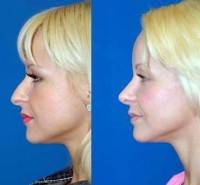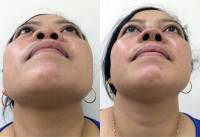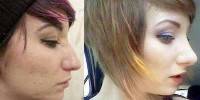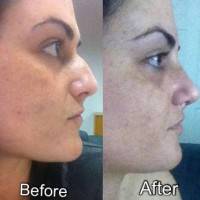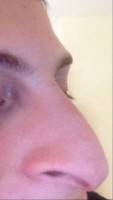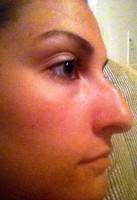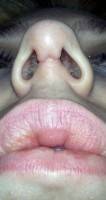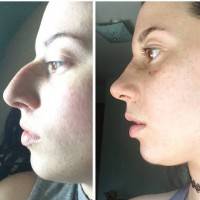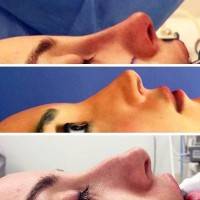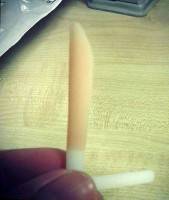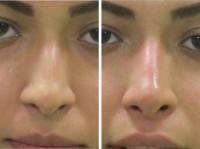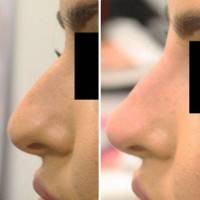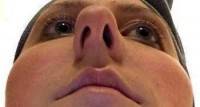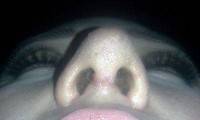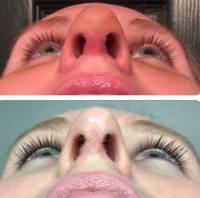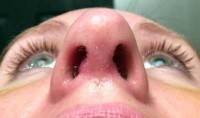Rhinoplasty is a correction of congenital or acquired deformities of the nose, as well as full restoration of the missing nose.
Rhinoplasty is a section of plastic surgery, which studies not only how to recover the missing nose and its parts through the replacement of defects by living tissues, but also ways of surgically correcting of congenital and acquired abnormal forms of the nose.
The task of rhinoplasty is to restore the correct forms, which were violated at the stage of embryogenesis or as a result of any disease, or mechanical (traumatic) injuries during life.
The nose is a fairly complicated architectural structure, participating in breathing with a difficult aesthetic load. By the contours of the nose at a subconscious level we externally identify a person, because the dimensions and the angles of the parts of the nose is very individual for each of us.
The size of the nose in men are associated with sexual possibilities. Most women want to have a neat little nose. Rhinoplasty is one of the most popular surgical procedures today.
The most exposed point on your face is the nose. Therefore deviations from the norm so sharply conspicuous for people. A norm for the nose is very vague, as it can be and should be considered only with the contours of the entire face. The latter also strictly individual and characterize the person. For example: The patient is not happy with a large nose; and in fact, it requires enlargement of a small chin.
Aesthetically straight nose is described in many textbooks on surgery. However, each patient has his own point of view on this issue. Therefore, computer simulations of future results conducted on the consultation. Great importance is attached for this.
The surgeon and the patient before the upcoming surgery must have the general idea of the changes. On the other hand must match the capabilities of the surgeon and the patient’s wishes.
The consultation describes the optical effects and changes around the nose or face, which can be obtained at correction only a individual structural elements.
If the common point of view of the doctor-patient relationship is found, the knowledge, skills and experience of the surgeon allowed to realize coveted in reality. At the same time will necessarily take into account the respiratory function of the nose.
Medical reasons for rhinoplasty
If you have congenital defects of the nose, rhinoplasty can be performed from 18 years, although the final formation of the nose ends to an average of 20 years (the formation of bone tissue of the nose ends in about 16-18 years, and cartilage – about 20 years). The optimum age for rhinoplasty – from 20 to 35 years.
Rhinoplasty is needed in the following cases:
- small hump on the bridge of the nose (dorsal hump);
- too pointed or thickened tip of the nose;
- hooked tip of the nose;
- the excessive length of the nose;
- dilated nostrils;
- saddle-shaped nose;
- curved nasal septum;
- congenital and post-traumatic deformation of the nose;
- violation or complete inability to nasal breathing.
Contraindications for rhinoplasty
- under 18 years old (in some cases there may be exceptions, such as in case of injury, the rhinoplasty can be performed at an earlier age);
- after the age of 40 years (due to the increased risk of complications, and slowing the healing of tissues due to the weakening of the regenerative processes);
- diseases of the cardiovascular system, in particular, coronary heart disease, heart failure and hypertension;
- liver and kidney diseases;
- diabetes;
- a bleeding disorder;
- folliculitis in the area of planned surgery;
- acne in the area of planned surgery;
- acute viral disease;
- cancer;
- mental illness.
Before performing rhinoplasty is recommended to visit a psychologist. There are instances when a person has a perfectly normal nose without any functional and aesthetic defects, but it seems that he or she needed surgery.
In such cases, the patient may have a diseases such like body dysmorphic disorder, and he requires no surgical treatment, but needs a psychologist and / or psychiatrist.
After special measurements, the surgeon can tell whether a person has the defects of the nose, or this is not observed. In oral and maxillofacial surgery exist the average parameters of the size and shape of the nose, as well as its harmonious arrangement relative to the eyes, forehead, ears, lips and chin.
Before surgery is also recommended to rest as much as possible, do not smoke, do not drink alcohol and do not take any medication without the doctor’s knowledge. On consultation with a plastic surgeon it is recommended to use computer simulation, with which you can see the expected appearance of the nose after surgery.
Rhinoplasty trauma
There are two problems after the trauma of the nose: impaired nasal breathing and changing the shape of the nose. It should be noted that in the case of injury, at an early stage of healing (first 10 days) without surgery, ambulatory, restores the original location of the nasal bridge (with lateral displacement, curvature).
Ability to restore degraded nasal breathing in other cases of shape changes is established during the inspection. If the injury was serious, the surgeon performs the reconstruction of the nose with the restoration of both external and internal structures.
Often, internal surgeries on a nose are executed after repeatedly postponed surgeries of rhinoplasty. Surgical intervention is considered necessary after undergoing injury, which may be accompanied by a violation of nasal breathing (deviated septum).
The surgery is desirable to perform in one step – to restore the physiology of respiration (submucosal resection of the nasal septum), and change the shape of the nose (rhinoplasty aesthetic).
Types of rhinoplasty
Distinguish the following types of correction of the nose:
Septoplasty
Is performed in the case of deviated septum. Deviated septum may be congenital or due to traumas. In addition, such bending may result from aging. In most cases (80%) septum of the nose can be a little deformed. However, the surgical treatment of this problem is required only if you have a violation of the nasal breathing.Closed Rhinoplasty
During closed rhinoplasty performed one or more incisions depending on the purpose for correction in the nasal cavity. The surgeon separates the skin of the nose of the nasal bones and cartilage that make up the skeleton of the nose.
After that the doctor can easily change their shape, remove excess cartilage or bone, increase the volume to achieve the desired shape. For example, to slightly narrow the nose the surgeon can remove the cartilage in the area of back of the nose.
Removal of the protruding portions of the nasal bones is carried out using a special tool – the chisel. When the surgeon will change the shape of the nasal bones and cartilage, he sews back section of the soft tissues. During closed rhinoplasty surgery the surgeon does not cut the columella. In most cases, rhinoplasty is performed by closed technique, without external incisions. If such a cut is needed, it is placed on the leg of columella in an inconspicuous area.Typically, the operation lasts about 1 hour and is performed under general anesthesia. Prior to the surgery, the surgeon carefully examines the respiratory function and performs plastic of nasal septum and the intervention on the lower nasal turbinates. It should be noted that for a good aesthetic and functional effect, preoperative examination of nasal breathing function is very important and should be carried out by highly qualified specialists and using the most modern diagnostic equipment, what is not really done in most clinics of plastic surgery.
If rhinoplasty requires the use of bone graft, it is taken either from the skull bone, either from the thigh or chest; In addition, when any type of autograft is not available, it can be used an artificial graft (nasal implant) to increase the bridge of the nose.To increase nasal bridge is preferable to use cartilage and bone grafts taken from the patient (not artificial), as this reduces the likelihood of histologic rejection and medical complications.
During surgery, the surgeon can perform the intervention only on the cartilage of the nose. Then the rehabilitation period is reduced to 5-7 days. It can also perform intervention on all structures of the nose (for cartilage and bone). In this case, the volume of surgery is increased, which requires a longer recovery period (12-14 days).
Open Rhinoplasty
Open rhinoplasty is performed in case of a large volume of interventions on the nose and in the case of repeated reconstructive surgery. During the procedure the incisions are made both in the nasal cavity (the edge cut, which is used are also isolated during open access), well as in columella – vertical fold of skin that separates the nostrils. After cut of soft tissue, the surgeon carries out manipulations on the nasal cartilage and nasal bones, as in the case of a closed rhinoplasty.Secondary rhinoplasty
Secondary rhinoplasty or revision rhinoplasty is performed to correct the problems that are left after the first rhinoplasty. Such problems may be both minor and rather difficult. Secondary rhinoplasty can be either open or closed.
Non-surgical rhinoplasty
It should be noted that non-surgical rhinoplasty is not a complete alternative to traditional rhinoplasty. With it can be corrected only minor defects. Among all patients seeking plastic surgeons for the purpose of rhinoplasty, only for 5-7% of patients the correction may be performed by one of the non-surgical methods.Rhinoplasty dermal fillers
In some cases the patient does not want to change the shape of the nose, but only to adjust some minor flaws such as smoothing sharp edges, nose angle change, restore the symmetry of the nose, etc. In such cases, the fillers may help. Since 2000, doctors began to successfully develop methods of non-surgical rhinoplasty with the use of modern fillers. They help to “round off” the tip of the nose, “remove” hollowness in the wings of the nose, “mask” bump, if small size.
Naturally, such a recovery period of rhinoplasty proceeds much easier, faster, and the operation cost in comparison with conventional rhinoplasty also significantly less. But the result of rhinoplasty using fillers persists for long. Nose retains a new kind of typically from a few months to one and a half years, because with time the fillers dissolve. The decay time depends on which what fillers have been used, as well as their level of quality. In some cases, fibrous tissue formed at the injection site, which remains after the resorption and repeated injections are required. Note that there is a possibility of “migration” of injected substance. It should also be noted that with multiple injections there is a possibility changes in the structure of tissues of the nose.Rhinoplasty using absorbable preparations
There are also special hormonal preparations that cause the resorption of tissue, allowing to eliminate bumps and bulges which does not like patient . This technique is often used to correct the tip of the nose, wings, nose and area above the tip. Rarely, using these drugs you can carry out the correction of the nose bone, such as a small hump.Surgery is necessary clearly define where you want to enter the drug and how much of it is required; the drug must be entered exactly in the bulge, from which the patient wants to get rid of. It is important make sure that the drug was absorbed little by little by all points. The results of such a correction can be seen in 2-3 weeks. Sometimes the procedure is carried out in several stages since the introduction of absorbable preparations must be careful.
Rhinoplasty using Aptos threads
With Aptos threads you can “tighten” the tip of the nose and to correct wings of the nose. Aptos threads are set through punctures and “tighten” the necessary parts of the nose. This technique is not widely used by surgeons in connection with a high probability of rough scarring at the site of the thread, contouring, thread breakage, which is probable, given the mobility of the nose.Rhinoplasty procedure and recovery
After the rhinoplasty, as a rule, there is a strong swelling of the nose and around the eyes. After surgery is necessary to wear a plaster cast for at least 7-10 days, if the osteotomy was performed. Swelling partially pass through 10-20 days. The preliminary result is evaluated after 6 months, the final – after 12 months. As a rule, the postoperative period does not cause to the patient painful sensations.
For some time the patient has to breathe through the mouth, if the surgeon finds it necessary to leave tampons in the nose for up to three days. Healing time depends on the individual and the age of the patient, so the doctor can call only approximate length of recovery.After removing the plaster you need to visit a doctor at specified intervals for inspection. After rhinoplasty it recommended to limit physical activity. Because in the first weeks a nose still weak and its easy to hurt. It is recommended to take time off from wearing glasses. In order not to provoke nosebleeds, it recommended to exclude from the diet of too hot and too cold food.
Complications from Rhinoplasty
- An allergic reaction to the anesthesia.
- Nosebleeds. Normally not dangerous, it blocked by swab. It may continue for 2-3 days.
- Edema of the nose. May cause difficulty of nasal breathing during an aftertreatment.
- Swelling, that apply to eyelids and other facial areas.
- Subcutaneous hematoma in the lower eyelids.
- Reduced sensitivity of the nose and the upper lip during the recovery period.
- Infections. Requires a course of antibiotics after surgery.
- Scar formation (scars). It may require repeated surgery for their correction.
- The difficulty of nasal breathing in the future (can occur when you remove a large hump from a narrow nose, as in this case hump serves as a vertical expansion of the nasal passages).
- Violation of smell.
- Perforation of the nasal septum.
- Atrophy of the nasal cartilage.
- Reduced skin elasticity of the nose and its “sagging”, leading to disruption of the tip shape of the nose (may occur when excessive removing bone and cartilage tissue).
- The formation of vascular meshes in the skin of the nose.
- The pigmentation of the skin of the nose, that remains for a long time.
- Necrosis of the nasal tissue (rare).
- Dissatisfaction the result of surgery.
Results from rhinoplasty
The decision for rhinoplasty each accept are individually. And it will not necessarily be approved by others, so the patient should be prepared for the unexpected reaction of friends and relatives.
Because it undergoes changes not only the shape of the nose, but the appearance in general. It may happen that relatives will splash out resentment because of the loss of family or ethnic facial features.
But often even the closest people do not notice a big change after the surgery because the shape of the nose takes conceived form for a long time, and swelling of tissues,that formed after the surgery, is masked the effect obtained.It should also be noted that the changes of the nose, obtained during surgery, are not inherited because plastic does not affect the genetics, but gives only the external effect. A full course of postoperative recovery lasts up to 6-8 months. That is why the final result of rhinoplasty should be evaluated no earlier than in the specified period.
Revision rhinoplasty
Particularly complex interventions are revision rhinoplasties that follow after unsuccessful rhinoplasty, or in cases where the surgery was relatively successful, but it does not meet the expectations of the patient (for example, the “new” nose can be “too corrected” and looks extraneously on the face, poorly combined with the other facial features).The predictability of the final form of the nose is usually not more than 70%. The result depends on the skill of the plastic surgeon and the individual characteristics of the patient.
About 30% of patients for various reasons, remain unsatisfied result of primary rhinoplasty. Implementation of secondary operations possible not earlier than 6 months after the initial intervention.
The reason for re-rhinoplasty can serve as:- Wrong stitched the cartilage that make abnormally short nose;
- Excessive reduction of columella, leading to the so-called “Blind nose” (columella looks drawn and is almost flush with the nostrils of the nose);
- Excessive removal of cartilage, resulting in a deformed shape of the tip of the nose;
- Excessive removal of the lateral cartilage.
